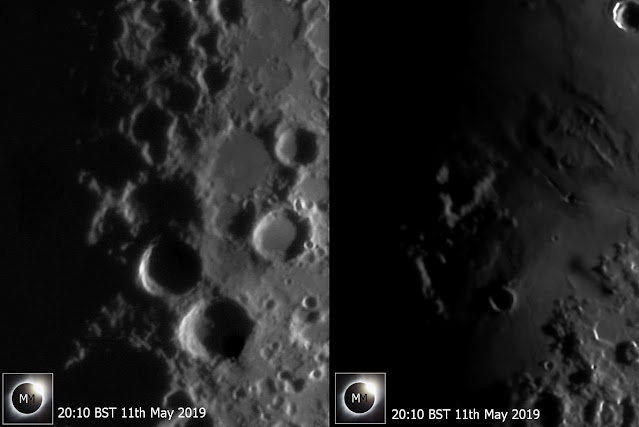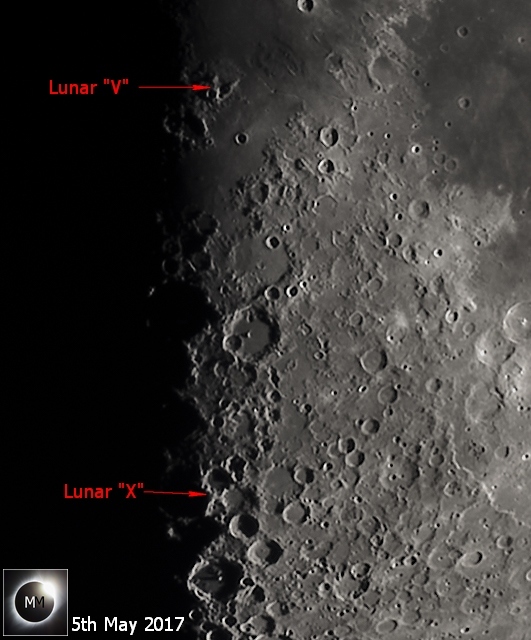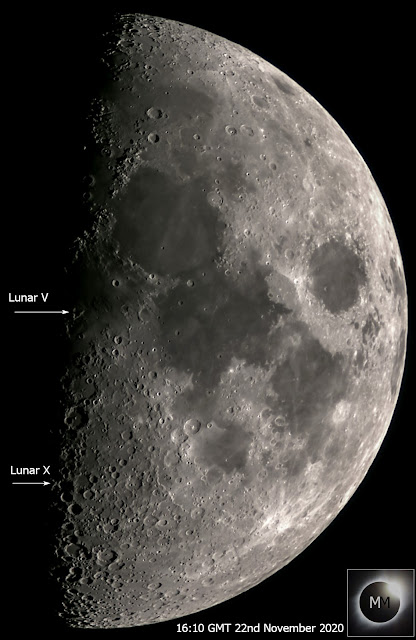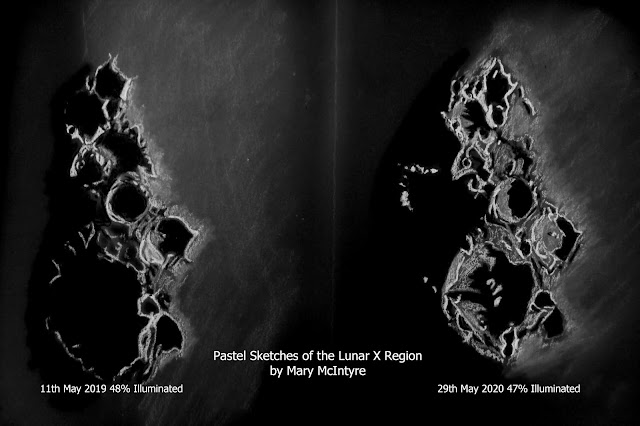
Lunar X and V Observing Times for 2022 by Mary McIntyre
NB: The table below is an image because the plain text version keeps getting scrambled. I'm so sorry if you're using electronic reading software that can't translate this, but you can download a PDF of this blog which should be readable here. The PDF is also printable for anybody wanting a physical print out of this information. Please feel free to share this information with anybody who may find it helpful.
More Information if you’re new to the Lunar X and V
The Lunar X and V are transient Clair Obscur effects which
are visible on the lunar surface once a month for about four hours. The “X” is
caused by light illuminating the rims of craters Blanchinus, La Caille and
Purback. The “V” is caused by light illuminating crater Ukert along with
several smaller craters. The X is at its
most striking when it is visible on the shadow side of the terminator (as shown
above). The X is located about a quarter of the way up from the bottom, just
inside the shadow side of the terminator. The V is approximately half way up
just inside the illuminated side of the terminator, and it really shines bright
against the darker background of Mare Vaporum. Once you know where to look, you
will be able to spot them with binoculars (it will help if they are mounted)
but they are best viewed through a telescope.
They will remain visible against the lunar surface for a few
hours even after the terminator has moved over them if you know where to look (see
photo below).
The lunar X can still
be seen for a short time when the Sun has risen over those craters, but it isn’t
as striking as when the X is the only illuminated thing in an otherwise unlit
part of the surface.
The X and V are visible close to the First Quarter phase,
however, due to libration, the exact time that they are visible is different
from month to month. The lunar phase illumination during which they can be seen
during 2022 varies between 42% and 54%.
The Lunar X is visible twice during November so that brings the total
number of apparitions during 2022 to thirteen.
To figure out what time the X and V become visible each month, I used the NASA Scientific Visualisation Studio Moon Phase and Libration tool for 2022 which you can view here.
I did this by scrolling through hour by hour near to First Quarter until I could see the X become visible; in previous years when I’ve observed the Lunar X using the start times from this tool, I have found it may take about 45 minutes from the start time before the X becomes clearly visible. The V tends to become visible a little earlier than the X. The start times are approximate, and they should be visible for a few hours after this. There is no fixed end-time listed because as mentioned above, these features remain visible even after the terminator moves across them, but if you assume they are visible for around four hours from the start time, you will see them at their best.
Although the X and V occur every month, the time may be before the Moon has risen or after it has set from your location, so you will not see them every month. Sometimes they are visible on a daytime Moon, when they are much more difficult to observe and photograph. The times given are in 24 hour clock and are in UT/GMT (and BST where appropriate) so you will need to correct for time zones and daylight time savings changes if you are not in the UK. I have also included the approximate moonrise and moonset times in the table. These times were taken from the Lunescope app on my phone so they relate to my location in Oxfordshire, UK. Your exact rise and set times will vary depending on where you are in the UK. You can check sunrise and set times for your location on the Time and Date website here.
Although technically there are several months of 2022 when the X and V are visible from the UK, Clair Obscur effects are difficult to observe on a daytime Moon and they are also harder to observe when the Moon is very low because of atmospheric disturbances. In May and December they will be visible on a rising daytime Moon and this will be a challenge for most observers. In August, October and the second apparition in November, they will become visible on the night-time moon but only for a short time before the Moon sets. The best months to see the X and V will be February, April and June.
It’s really great fun to observe how the Lunar X
and V regions evolve over time, so if you do make the effort to see them when
they first appear, make sure you check that region again periodically to see
how things have changed. The sketches
below show how different the Lunar X region can look once the terminator has
passed over it. If you enjoy observing the X and V, there many other Clair Obscur
effects that are well worth seeking out. There is comprehensive list of them on
Wikipedia here.
I really hope you found this post helpful. Once again, please feel free
to share it with anybody who may find it useful.
Clear skies!
Mary McIntyre FRAS



